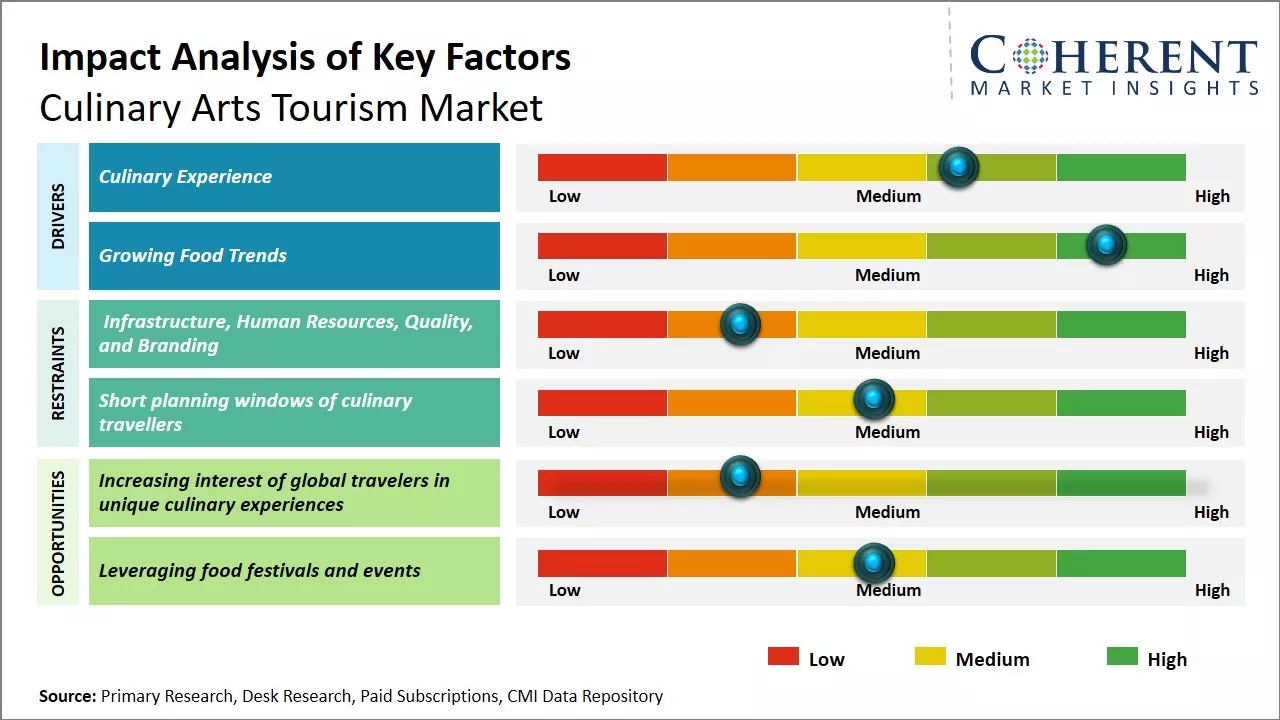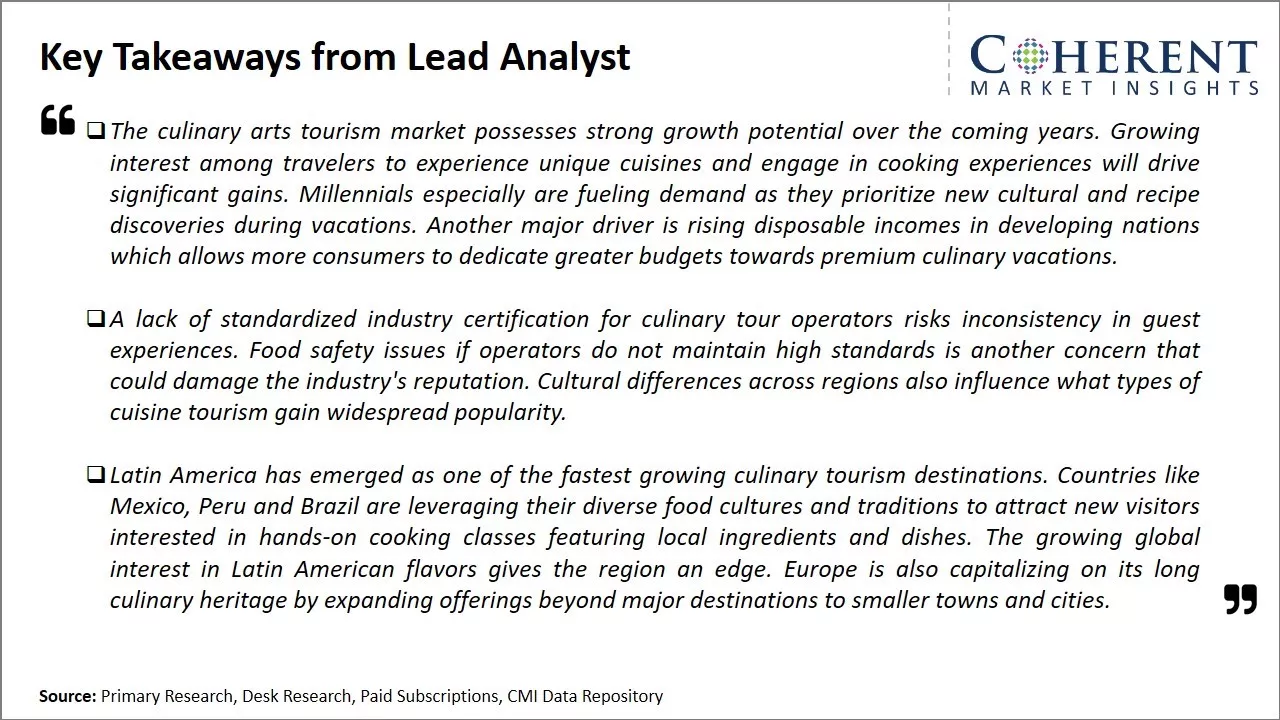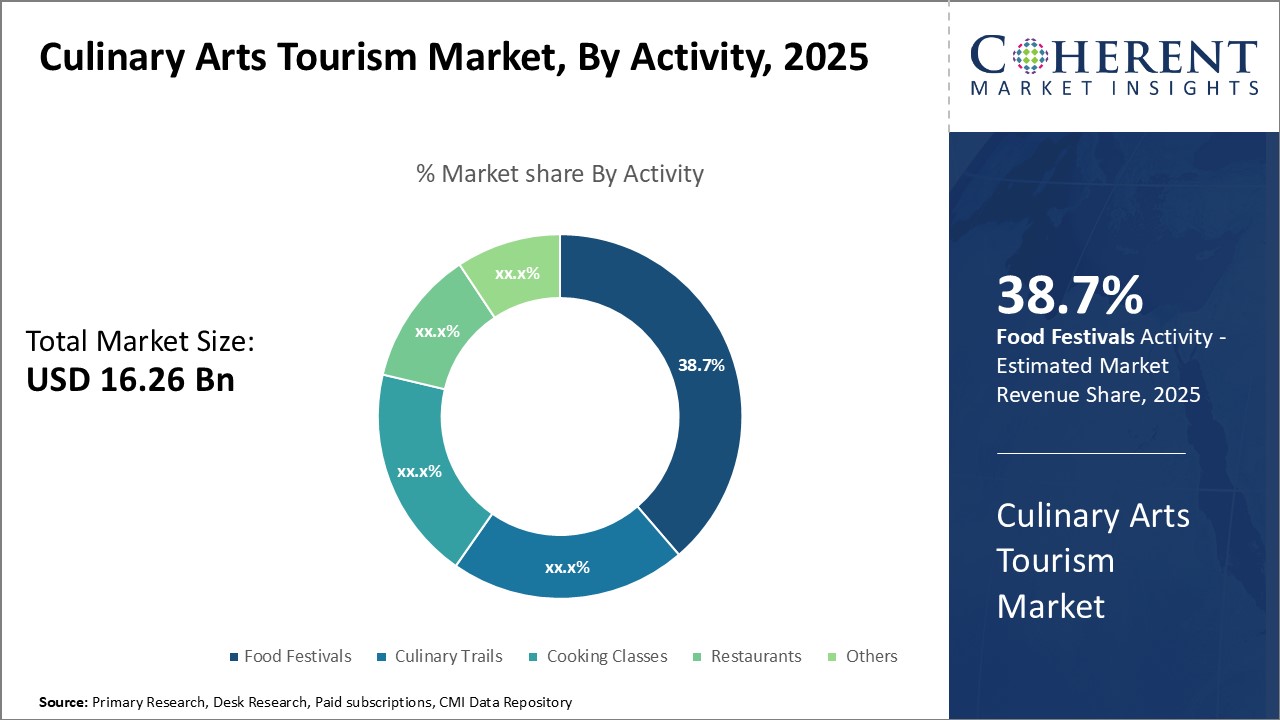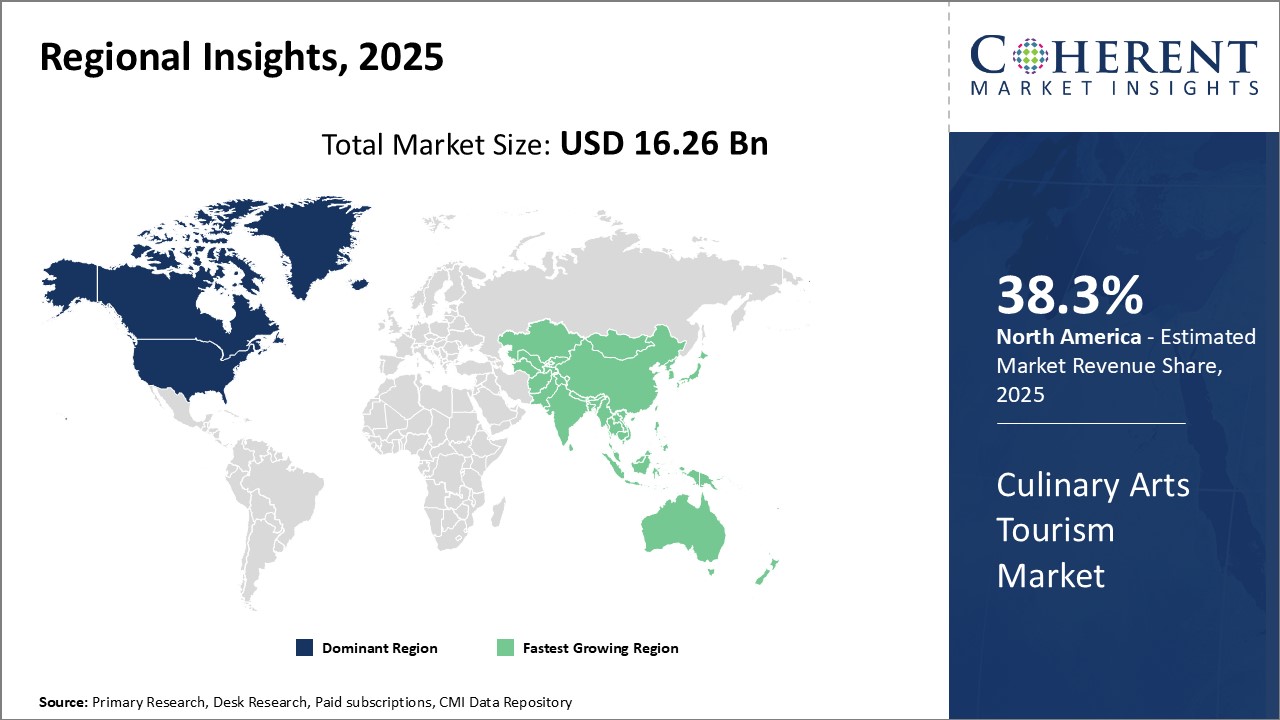Culinary Arts Tourism Market Size and Trends
The culinary arts tourism market is estimated to be valued at USD 16.26 Bn in 2025 and is expected to reach USD 54.97 Bn by 2032, growing at a compound annual growth rate (CAGR) of 19.0% from 2025 to 2032.

Discover market dynamics shaping the industry: Download Free Sample
The market is expected to witness significant growth over the forecast period. Factors, such as increasing disposable income, growing passion for new cuisines and cooking experiences, social media influence, and customizable travel packages, are expected to drive more people towards culinary tours and activities. Food and culinary experiences are increasingly becoming an integral part of the travel and tourism experience. As travelers look for new and authentic ways to experience local culture, food travel will continue to open up new opportunities for tourism destinations and businesses. Customized itineraries, social media engagement, and focus on niche and specialized food experiences are expected to be key trends that boost the culinary arts tourism market in the coming years.
Culinary experience
The desire to experience local cuisines has become one of the driving factors for culinary tourism. Travelling to new places is no longer just about sightseeing but also tasting diverse foods that tell the story of culture. People want authentic cooking experiences that allow them to peek into how local communities cook and eat. This provides a deeper feeling of immersing into a destination and connecting with locals on a more human level. Food tours, cooking classes, and cuisines unique to regions have become major attractions. Tourists looking for these experiences are willing to spend on private or group sessions with locals. Some destinations have witnessed entire economies developing around culinary tourism such as food specialties leading to employment for locals as chefs, guides, or small business owners. Festivals centered on cuisines have also sprung up in many destinations, further fueling this growing trend. As travel videos and food shows expand global exposure to diverse cuisines, the allure of experiencing culture through food also gives tourists memorable takeaways from their journey.
Market Concentration and Competitive Landscape

Get actionable strategies to beat competition: Download Free Sample
Growing Food TrendsChanging global food habits and focus on wellness has given rise to new forms of culinary tourism. Demand for unique super foods, ancient grains, traditional fermented, and prebiotic foods from around the world has grown markedly. Travelers seek locales producing niche items to learn about their nutritional benefits and taste them in their place of origin. Growing interest in foraging, organic farming practices and sustainably sourced ingredients also pulls visitors towards destinations promoting these lesser known foods. Culinary adventure experiences coupled with health and wellness modules have found favor with particular tourist profiles. Even trends around vegan, vegetarian, gluten-free, and paleo diets mean tourist spots innovating local cuisine to suit these preferences see a rise in numbers. Food tourism that doubles up as an educational exploration of specialty local produce are appealing greatly to certain conscious consumer groups. In health retreats or farm stays, the concept of nourishment with a purpose aligns well with modern lifestyles. This allows regions with such distinctive food strengths to augment tourism revenues.

To learn more about this report, Download Free Sample
Market Challenges: Infrastructure, Human Resources, Quality, and BrandingThe culinary arts tourism market faces several challenges. Many aspiring culinary tourism destinations lack adequate infrastructure and facilities to meet international standards. Additionally, a dearth of experienced local chefs, guides, and other human resources poses difficulties for delivering premium experiences. Another major roadblock is inconsistent quality of food offerings and accommodation. Building a strong brand image also takes significant time and investment due to fierce competition globally.
Market Opportunities: Increasing interest of global travelers in unique culinary experiences
Increasing interest of global travelers in unique culinary experiences provides opportunities for destinations to showcase their indigenous food cultures. Demand for customized experiential tours focused on sourcing local ingredients or visiting farms/producers has been rising steadily. Emerging destinations can leverage their untouched beauty and cuisine to attract new target segments. Partnerships with global hospitality brands may help address resource crunch to some extent.

Discover high revenue pocket segments and roadmap to it: Download Free Sample
Insights, By Activity: Culinary Passion Drives Participation in Food FestivalsIn terms of activity, food festivals contribute 38.7% share of the culinary arts tourism market owing to the passion many tourists have for experiencing diverse cuisines firsthand. Food festivals allow tourists to sample an extensive variety of dishes over a condensed period of time, satisfying their curiosity about regional flavors and ingredients. The temporal and spatial concentration of culinary experiences at festivals makes sampling many options convenient and memorable. Colorful festival atmospheres that celebrate food as culture further pique people's interest and match their desire for fun and novelty seeking. Many food festivals include cooking demonstrations or have competition components that offer a glimpse into food preparation, bringing attendees closer to the artistry behind dishes. This experiential and participatory element feeds the growing interest in cooking skills and deeper food knowledge. Festivals that highlight food traditions or pair cuisine with live music, crafts or other attractions allow tourists to learn about cultural identities through the tangible, sensory experiences of tasting. The connection of cuisine to cultural heritage and sense of place deepens the meaningfulness of food festivals for existential tourists. The programming of special or limited-time menu items just for festivals lures locals and visitors back year after year to scratch nostalgia itches or taste innovations. Souvenir recipe books and cookware for sale extend the memorable aspect of festivals beyond the event itself. Most festivals now promote themselves heavily through social media, fueling word-of-mouth buzz that compounds the draw of communal, celebratory experiences centered on indulgence in local flavors and cultures.
Insights, by tourist Type: Quest for Authentic Culinary Journeys Drives Trail Participation
In terms of tourist type, existential tourists contribute 32.8% share of the culinary arts tourism market as they seek authentic connections to place through food. Culinary trails are uniquely positioned to satisfy this quest, offering curated itineraries that deepen tourists' understanding of cuisine's relationship to regional identity, farming practices, food ways and traditions. Trails provide structured yet flexible experiences, allowing existential tourists to immerse themselves in the stories behind dishes or indigenous ingredients at their own pace over extended visits. Multi-day trails encourage meaningful interactions with artisan producers, chefs and cultural experts along the journey that give richer context than brief food festival encounters. Participating in harvesting, butchering or milling activities provides hands-on understanding of the origins and authenticity of local fare. Existential tourists value intense yet comfortable travel that forges personal growth, and curated trails designed for cultural appreciation eliminate much of the planning required to piece together such an impactful trip themselves. Learning directly from community experts transforms ephemeral culinary tourism into a profound reminder of food's ability to represent localized heritage, livelihoods and folkways. Regional trails therefore become almost pilgrimages for those seeking self-actualization through food-based cultural immersion. Word of mouth leads like-minded existential tourists to highly-rated trails year after year.
Insights, By Booking Mode: Online Ease and Options Drive Direct Travel Bookings
In terms of booking mode, direct travel contributes 42.6% share of the culinary arts tourism market because it removes friction from the planning process. Booking directly through accommodation or activity providers allows tourists to customize trip components at their leisure from the comfort of online research sessions. Rather than relying on package options constrained by intermediaries, direct booking empowers tourists to mix-and-match exact classes, attractions and lodgings that suit individual interests, schedules and budgets. Constantly updating merchant websites and social media profiles keep direct travel options fresh and enticing at tourists’ fingertips. The virtual marketplace created through numerous direct booking sites simplifies one-stop shopping for every element of a culinary arts focused trip. Side-by-side comparisons assist with optimizing the experience without wasting time filling out multiple reservation forms or calling multiple contacts. User reviews further ease decision making, removing uncertainty associated with less transparent options. For budget-conscious or spontaneous culinary tourists in particular, last-minute direct booking availability allows trips to be assembled affordably around specific festivals or seasonal attractions. The seamlessness of online direct reservations, research, and payment continues fueling growth in a segment that minimizes stressful planning hurdles.
Regional Insights

Need a Different Region or Segment? Download Free Sample
North America has established itself as the dominant region in the global culinary arts tourism market with 38.3% of the market share. With strong cultural influence from various immigrant populations over decades, diverse regional cuisines have developed across the U.S. and Canada. Some of the prominently distinct cuisines are Mexican food in the Southwestern states, Louisiana Creole/Cajun fare, Southern barbecue, and Pacific Northwest seasonal ingredients among others. The region also accounts for major culinary destinations like New York, Los Angeles, Chicago, and Toronto that receive a large number of both domestic and international foodie travelers each year. With its robust food and beverage industry heritage, North America has a wide network of prominent culinary schools, chef associations, and hundreds of farmers' markets that attract visitors interested in experiencing authentic local flavors.
Meanwhile, the Asia Pacific region has emerged as the fastest growing culinary tourism hub over the past 5 years. Countries like Vietnam, Japan, Thailand, India, and Indonesia have increasingly embraced the concept and witnessed substantial visitor arrivals on food-oriented trips. Traditional cooking techniques and diverse native ingredients are the major attractions. For instance, Vietnamese pho noodle soup, Japanese sushi, Thai curries, and Malaysian laksa offer immersive cultural experiences beyond just tasting the flavors. The Asia Pacific region's rapid economic development has also raised disposable incomes and expanded the middle class population keen on culinary travels. With lower travel costs compared to Western destinations, the region presents significant opportunities for future market expansion. Promoting niche regional foods through culinary festivals and guidebooks is fueling further interest.
Market Report Scope
Culinary Arts Tourism Market Report Coverage
| Report Coverage | Details | ||
|---|---|---|---|
| Base Year: | 2024 | Market Size in 2025: | USD 16.26 Bn |
| Historical Data for: | 2020 To 2024 | Forecast Period: | 2025 To 2032 |
| Forecast Period 2025 to 2032 CAGR: | 19.0% | 2032 Value Projection: | USD 54.97 Bn |
| Geographies covered: |
|
||
| Segments covered: |
|
||
| Companies covered: |
Abercrombie & Kent USA, LLC, Greaves Travel Ltd, India Food Tour, Classic Journeys, LLC, The FTC4Lobe Group, The Travel Corporation, Gourmet on Tour, Culinary Adventures International, Culinary Tours, Butterfield & Robinson Inc., International Culinary Tours, and Forks on the Road |
||
| Growth Drivers: |
|
||
| Restraints & Challenges: |
|
||
Uncover macros and micros vetted on 75+ parameters: Get instant access to report
Culinary Arts Tourism Industry News
- In July 2023, Halekulani, the iconic oceanfront luxury hotel in the heart of Waikiki, announced an exclusive culinary experience in collaboration with The Imperial Hotel Tokyo at La Mer, Hawaii's only AAA Five Diamond, and Forbes Five-Star restaurant
- In December 2022, A&K Travel Group Ltd., the company that owns Abercrombie & Kent, Crystal Cruises, and Cox & Kings, announced its equity partnership with Ecoventura, a sustainable travel company of the Galapagos Islands. This partnership foresees an equity investment in Ecoventura and the creation of a joint venture.
*Definition: The culinary arts tourism market involves tourists who travel to experience a destination's cuisine, cooking techniques, traditions, and culture related to food. It targets visitors interested in tasting local foods, attending cooking classes or demonstrations, visiting farms, markets and food processing plants, dining at renowned restaurants and participating in food festivals. Culinary arts tourism helps promote a region's agricultural products and dishes while also boosting its economic development through food and beverage-related tourism spending.
Market Segmentation
- Activity Insights (Revenue, USD Bn, 2020 - 2032)
- Food Festivals
- Culinary Trails
- Cooking Classes
- Restaurants
- Others
- Tourist Type Insights (Revenue, USD Bn, 2020 - 2032)
- Recreational
- Diversionary
- Existential
- Experimental
- Booking Mode Insights (Revenue, USD Bn, 2020 - 2032)
- Online Travel Agencies (OTA)
- Tour Operators
- Direct Travel
- Regional Insights (Revenue, USD Bn, 2020 - 2032)
- North America
- U.S.
- Canada
- Latin America
- Brazil
- Argentina
- Mexico
- Rest of Latin America
- Europe
- Germany
- U.K.
- Spain
- France
- Italy
- Russia
- Rest of Europe
- Asia Pacific
- China
- India
- Japan
- Australia
- South Korea
- ASEAN
- Rest of Asia Pacific
- Middle East & Africa
- GCC Countries
- Israel
- Rest of Middle East & Africa
- North America
- Key Players Insights
- Abercrombie & Kent USA, LLC
- Greaves Travel Ltd
- India Food Tour
- Classic Journeys, LLC
- The FTC4Lobe Group
- The Travel Corporation
- Gourmet on Tour
- Culinary Adventures International
- Culinary Tours
- Butterfield & Robinson Inc.
- International Culinary Tours
- Forks on the Road
Share
Share
About Author
Yash Doshi is a Senior Management Consultant. He has 12+ years of experience in conducting research and handling consulting projects across verticals in APAC, EMEA, and the Americas.
He brings strong acumen in helping chemical companies navigate complex challenges and identify growth opportunities. He has deep expertise across the chemicals value chain, including commodity, specialty and fine chemicals, plastics and polymers, and petrochemicals. Yash is a sought-after speaker at industry conferences and contributes to various publications on topics related commodity, specialty and fine chemicals, plastics and polymers, and petrochemicals.
Missing comfort of reading report in your local language? Find your preferred language :
Transform your Strategy with Exclusive Trending Reports :
Frequently Asked Questions
EXISTING CLIENTELE
Joining thousands of companies around the world committed to making the Excellent Business Solutions.
View All Our Clients
